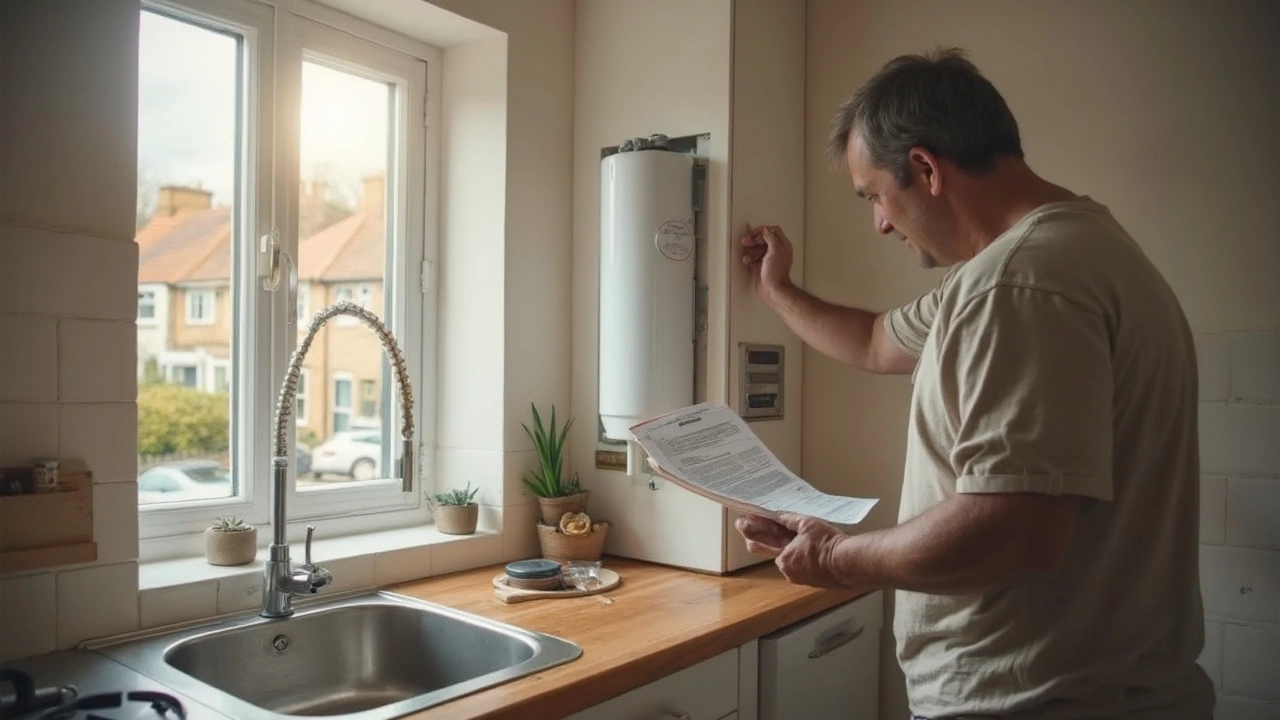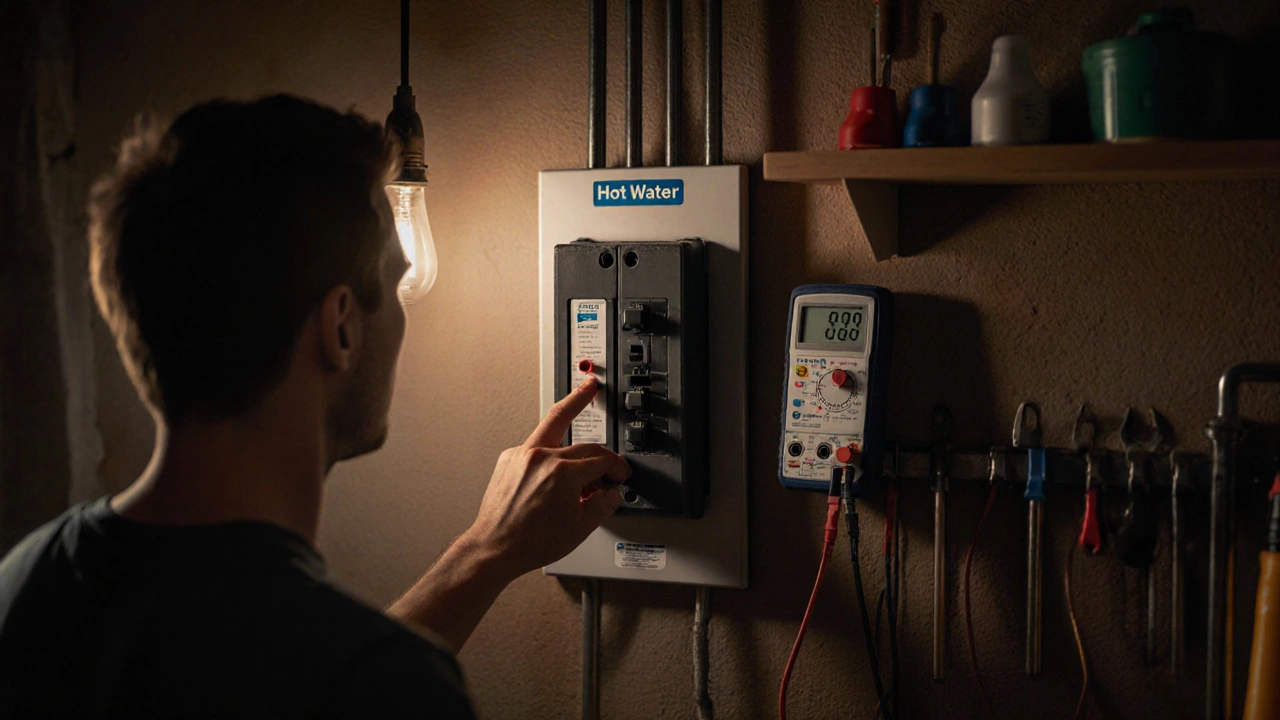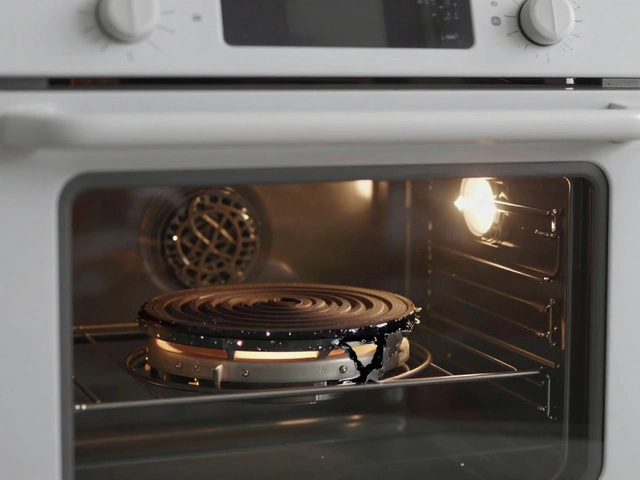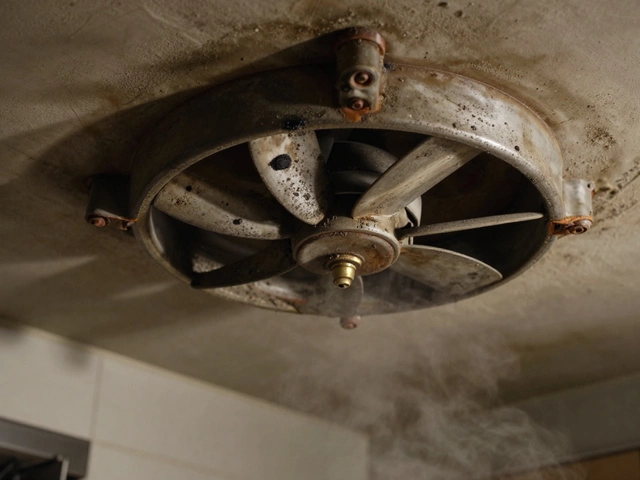Hot showers turning lukewarm way too fast? That’s usually the first red flag your water heater element might be on its last leg. Before you freak out or call a plumber, there are a few easy things you can look for right at home. Most of the time, a tank that makes groaning sounds, delivers only cold or barely warm water, or trips the breaker means the element’s not pulling its weight.
No fancy tools needed to spot the basics. Pop open the access panel (after turning off the power, seriously), and give the wires and thermostat a quick look for obvious damage or burnt spots. Sometimes, a bad smell from the tank or rusty water in the sink is another clue the element’s gone bad. Spot one of these signs? Now you know where to start looking before getting into any complicated stuff.
- Classic Signs Your Water Heater Element Is Toast
- Simple At-Home Checks Before Grabbing Tools
- How to Test the Element with a Multimeter
- Common Causes Behind Element Failure
- Should You Fix It Yourself or Call a Pro?
- Tips to Prevent Water Heater Issues
Classic Signs Your Water Heater Element Is Toast
If your water heater element is shot, it’s not shy about showing it. The first thing you’ll usually notice is a serious drop in hot water. Maybe your morning shower turns chilly halfway through, or the kitchen tap never gets more than lukewarm.
- Cold Water from Hot Tap: This is the big giveaway. If you’re getting straight cold water—even after letting the tank heat up—the top or bottom element is probably dead.
- Inconsistent Water Temps: Sometimes, you’ll get hot water, just not as much. If your tank has dual elements, one may be out while the other struggles to keep up, so you only get half the hot water you’re used to.
- Water Takes Forever to Reheat: A bad water heater element means the tank struggles to recover. Instead of waiting 30–60 minutes, you could be waiting hours.
- Strange Noises: Elements covered in mineral buildup can start buzzing, sizzling, or popping when they heat water. These sounds mean something’s going wrong inside the tank.
- Breaker Keeps Tripping: Older or shorted elements can trip your breaker whenever the water heater kicks on. If this only happens when you try to use hot water, the element is a strong suspect.
- Visible Damage: If you dare peek behind that panel (always with the power off), look for scorched wiring, blackened spots, or melted plastic—that’s all bad news.
For electric water heaters, about 90% of "no hot water" calls are traced to a faulty element or thermostat. Simple clues like these can save you from guessing and help you land on the real problem fast.
Simple At-Home Checks Before Grabbing Tools
Before you start hunting for your toolbox, there are a few things you can do to figure out if your water heater element is the culprit. Most folks skip these steps and waste time or money, but these checks can save you both.
First off, go to your breaker panel. A tripped breaker is classic when a water heater element shorts out. Flip it back and see if your hot water comes back. If the breaker trips again—yep, something’s definitely wrong with the element or wiring.
Next up, do a quick feel test. Run the hot tap for a minute. If you get a little burst of hot and it fades fast, your upper element is probably okay but your lower one isn’t. If you get nothing but cold or lukewarm water, both elements might be shot.
Listen for weird sounds from the heater. Popping and hissing sometimes mean sediment is cooked onto the element, making it work harder—or not at all. Smell the water, too. A burnt odor can point straight to a bad electric water heater element.
If your tank is less than five years old, element trouble is way less common, since most heaters last 8–12 years and the element only fails early if you’ve got hard water or major sediment. Want a quick way to keep track? The table below gives you a cheat sheet on what you might hear, see, or smell:
| Clue | What It Means |
|---|---|
| Breaker keeps tripping | Possible shorted element or wiring |
| Hot for a minute, then cold | Lower element failure |
| No hot water at all | Both elements or thermostat bad |
| Popping or hissing noises | Sediment build-up on element |
| Rusty or smelly water | Element corroded or anode rod gone |
Run through these zero-tool checks before you spend a dime. They’ll help you pin down the problem and talk to a pro—or try a DIY fix—without wasting time on guesswork.
How to Test the Element with a Multimeter
If you want a definite answer about your water heater element, grab a multimeter. This little gadget makes it super easy to see what’s working and what’s toast. You don’t need to be a pro, but you do need to be careful—electricity and water heaters aren’t a combo to mess around with. Always cut the power at the breaker before you get started.
Here’s how you check a water heater element step by step:
- Turn off power to the water heater at your main panel. Even if you’re not doing anything yet, this is non-negotiable.
- Take off the cover panel on the water heater (usually just a couple screws). Move aside the insulation—just enough to see the thermostat and element.
- Use your multimeter and set it to the lowest resistance (ohms, sign looks like Ω).
- Unscrew one wire from the heating element’s terminal. This makes sure you’re testing only the element, not the whole circuit.
- Touch one multimeter probe to each screw on the element. If you get a reading between 10 and 30 ohms for most residential 240V elements, congrats—the element isn’t totally shot. Any reading way outside that range, or nothing at all (infinity symbol), means your water heater element is likely dead.
Take a look at what the results usually mean:
| Multimeter Reading | What It Means |
|---|---|
| 10-30 Ω | Healthy element |
| 0 Ω or infinity | Element is burned out |
| Any other number | Element is faulty or dying |
Some folks forget to check for grounding, which can cause tripped breakers. Set your multimeter to continuity mode (or the lowest ohms again) and touch one probe to an element screw and the other to the metal tank. If it beeps or shows any reading, your element is shorted to ground and has to go.
This isn’t rocket science, just careful checking. A multimeter tells you in seconds if the water heater element is your problem—or if you should be hunting somewhere else for the fix.
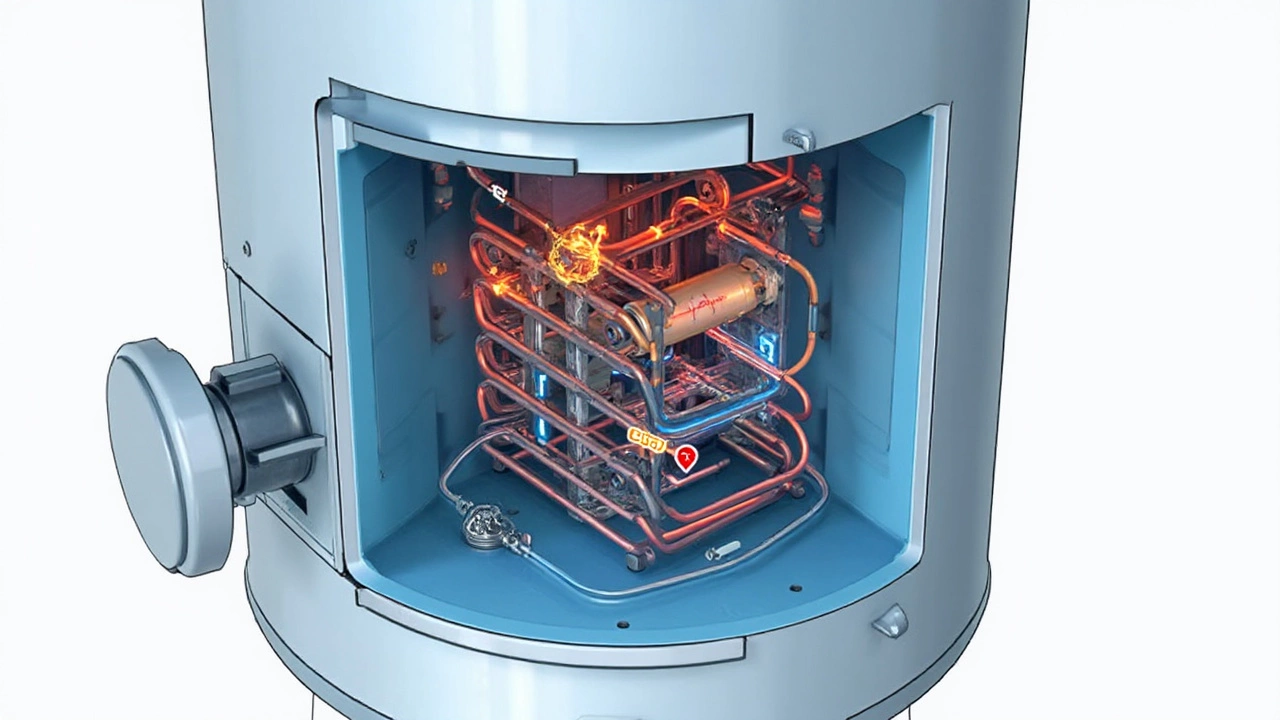
Common Causes Behind Element Failure
Wondering why your water heater element decides to pack it in? Blame it on the list of usual suspects. First up: mineral buildup. If you live anywhere with hard water, calcium and lime love to collect on the heating element. Over time, that thick crust acts like insulation—forcing the element to work harder until it just gives up.
Another common reason is a dry fire. This happens when your tank is emptied but the power stays on. The element can’t cool itself in air, so it overheats and burns out fast. Swapped out your element lately? Rough handling during install can crack the element or damage the wiring. Poor connections or loose wiring mean the element sometimes won’t get enough juice or will short out prematurely.
- Mineral buildup: Major headache in older tanks and hard water areas.
- Dry firing: Heaters turned on when the tank isn’t full—easy mistake, deadly for elements.
- Corrosion: Over time, water attacks the metal, especially if your anode rod is gone or worn out.
- Electrical issues: Bad thermostats or worn wiring can burn out your element even if it’s brand new.
If you’re curious how common this stuff is, check out these estimated lifespans:
| Element Issue | Average Lifespan (Years) |
|---|---|
| Normal use (little mineral) | 6-10 |
| Hard water/mineral buildup | 2-4 |
| Frequent dry firing | 1-3 |
So, if your electric water heater element keeps dying on you, it’s usually something on this list. Keep an eye out for these problems, and you’ll save cash and frustration in the future.
Should You Fix It Yourself or Call a Pro?
This is where a lot of folks end up stuck. Swapping a water heater element sounds easy, but there’s a bit more to it than just unscrewing stuff. If you’re handy and know how to safely cut the power (double-check that breaker), you can tackle most element swaps with just a screwdriver and a socket wrench. A new element usually runs under $30. The whole job usually takes under an hour once you know what you’re doing.
But here’s the thing: water and electricity do not mix. Even if the tank is apparently off, it pays to triple-check with a voltage tester before touching anything. Stats say nearly 15% of household electrical fires start due to DIY wiring mistakes—worth thinking about before you dive in. If you spot melted wires, heavy corrosion, or don’t feel 100% about draining the tank, it’s better to call a pro.
- If your water heater is still under warranty, DIY repairs might cancel it—check the paperwork first.
- If you see leaks coming from the tank body, that’s a sign of a much bigger problem. Don’t risk it solo.
- If you don’t own a multimeter or aren’t sure how to test for a bad water heater element, you’re better off getting help.
Plumbers usually charge $100–$200 for a full water heater element replacement. Many will inspect the unit, test other parts, and play it safe—especially if your home’s wiring is older or was DIYed by a previous owner. If you try it yourself, watch a video or check the manufacturer’s instructions for your exact model before you start tearing things apart. Saving a few bucks isn’t worth frying your heater—or yourself.
Tips to Prevent Water Heater Issues
Long before your water heater element gives out, a little attention can save you a bunch of hassle (and cold showers). Most problems boil down to neglect, so a bit of routine care goes a long way.
First up, fight off mineral buildup. If you live in a hard water zone, your tank gets crusty inside—those minerals love to cling to heating elements and burn them out. Every year, drain a few gallons from the tank. Put a bucket under the drain valve, open it up, and let water (and gunk) flow out until it runs clear.
- Check the thermostat settings: Keep it around 120°F. Higher than that and you risk overheating the electric water heater element and wasting energy.
- Flush your tank once a year: This stops sediment from baking onto the element and keeps your heater running smoother, longer.
- Inspect electrical connections: If any wires look frayed or burnt, shut off the power and tighten them up or call a pro. Loose connections make the element overwork and fail faster.
- Test the pressure relief valve: Lift the lever for a quick burst of water. If nothing happens, you’ve got a safety issue that needs attention.
- Keep an eye on water color: Rusty or dirty water often means corrosion. Don’t ignore it—it can eat away at the heater from the inside out.
One study from the U.S. Department of Energy found that routine maintenance can extend a tank-type heater's life to 10–15 years. That’s huge compared to the seven or eight years people usually get when they ignore maintenance.
| Tip | How Often |
|---|---|
| Flush Tank | Once a year |
| Check Thermostat | Every 6 months |
| Inspect Elements | Yearly |
| Test Relief Valve | Every year |
As plumbing expert Mike Holmes puts it:
"Ignoring water heater maintenance is like skipping oil changes for your car—you’ll get away with it for a while, but sooner or later, it’s gonna bite you."
With these habits, you’ll keep your water heater element and everything else running smoother for way longer—saving you money and headaches down the road.

